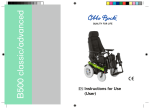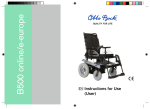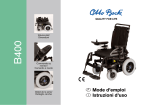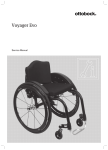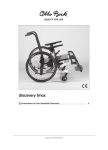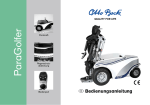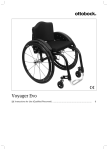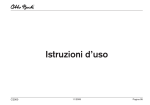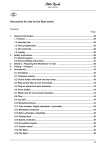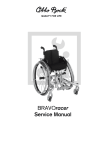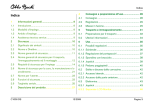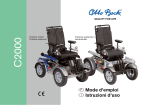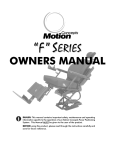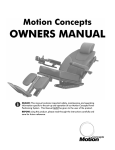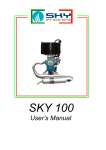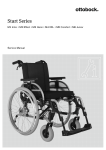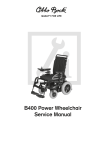Download ParaGolfer
Transcript
ParaGolfer Transportation size Rain cover Control panel Instructions for Use Table of Contents Table of Contents 4 Delivery and Preparation for Use......................... 24 1 General Information............................................... 6 4.1 1.1 Preface................................................................... 6 4.2 Delivery................................................................. 24 4.3 Initial Operation..................................................... 25 1.2 Intended Use........................................................... 6 1.4 Technical Service.................................................... 7 1.3 Field of Application.................................................. 7 2 Safety Instructions................................................. 8 2.1 Explanation of Symbols........................................... 8 2.3 General Safety Instructions..................................... 9 2.2 2.4 2.5 2.6 Standards and Directives........................................ 8 Safety Requirements for Transportation, Storage and Assembly.......................................... 10 Safety Requirements for Operation........................ 11 Safety Requirements for Care, Maintenance and Disposal.................................... 17 2.7 Requirements for the User..................................... 19 2.9 Warning Signs and Information Signs................... 20 2.8 3 Safety Functions................................................... 19 Product Description............................................. 23 ParaGolfer Settings................................................................. 25 5 Transportation and Storage................................. 26 5.1 Transportation....................................................... 27 6 Operation............................................................. 29 6.1 Setting Options..................................................... 29 5.2 Storage................................................................. 28 6.1.1 Seat Depth............................................................ 30 6.1.2 Seat Width............................................................ 32 6.1.3 Lower Leg Length................................................. 32 6.1.4 Backrest............................................................... 33 6.1.5 Armrests............................................................... 34 6.1.6 Control Panel........................................................ 35 6.2 6.3 Getting Into and Out of the Sports Wheelchair...... 36 Fixation................................................................. 37 6.3.1 Lap Belt................................................................ 37 6.3.2 Knee Belt with Knee Pad....................................... 38 6.3.3 Chest Belt............................................................. 38 02/2010 Page 3 Table of Contents 8.2 Error...................................................................... 60 9 Maintenance, Cleaning and Disinfection............. 63 6.4.3 Driving Function.................................................... 42 9.1 Maintenance Intervals........................................... 63 6.4.5 Drive-away Lock.................................................... 45 9.3 Wheel Replacement.............................................. 65 6.4 Control Unit........................................................... 40 6.4.1 Control Panel........................................................ 40 6.4.2 Switching On and Off............................................ 42 6.4.4 "Battery Capacity” Indicator.................................. 44 6.5 6.6 6.7 Stand-up Function................................................. 46 Releasing and Locking the Brake.......................... 49 Batteries............................................................... 51 6.7.1 Charging............................................................... 51 6.7.2 Battery Charger.................................................... 53 6.7.3 Battery Disconnect Switch.................................... 55 7 Accessories.......................................................... 55 7.1 Golf Bag Holder.................................................... 56 7.2 8.3 9.2 9.4 Defect / Failure...................................................... 63 Changing the Fuse................................................ 65 Cleaning and Care................................................ 67 10 Technical Data..................................................... 68 11 Disposal............................................................... 70 12 Information on Re-Use......................................... 71 13 Liability................................................................. 71 14 CE Conformity...................................................... 72 Control Panel Holder............................................. 57 7.2.1 Control Panel Holder with Spring Plate................. 57 7.3 Decorative Rim Covers.......................................... 58 8 Malfunctions / Troubleshooting............................ 59 8.1 Warning................................................................ 59 7.4 Page 4 Rain Cover for Storage Compartment................... 58 02/2010 ParaGolfer List of Figures Fig. 15 List of Figures Fig. 1 Signage on the ParaGolfer.............................. 20 Fig. 3 Fuse................................................................ 26 Fig. 2 Fig. 4 Fig. 5 Fig. 6 Fig. 7 Fig. 8 Fig. 9 a Fig. 9 b Fig. 10 Fig. 11 Fig. 12 Main components of the ParaGolfer................ 25 Transportation size of the ParaGolfer.............. 27 Loosening the screws on the seat rail.............. 31 Locking pins on the seat rail ........................... 31 Lateral pad..................................................... 32 Turning the spindle.......................................... 32 Fig. 16 LCD display with all symbols........................... 41 Fig. 18 Display of the standing function....................... 48 Fig. 17 Fig. 19 Fig. 20 Fig. 21 Display of the drive-away lock on the control panel......................................... 46 Display of the creep speed on the control panel......................................... 48 Brake release lever and safety pin................... 49 Operating the brake release lever and safety pin................................................. 50 Loosening the clamps..................................... 33 Fig. 22 Loosening the screws on the bottom side of the armrest holder . ............................. 34 Fig. 24 Screws on the control panel rail on the underside of the armrest.................................. 36 Fig. 26 Golf bag holder attached................................ 57 Fig. 28 Rain cover....................................................... 58 Adjusting the backrest height.......................... 34 Release pin on the armrest.............................. 35 Fig. 13 a Hooking in the knee belt.................................. 38 Fig. 13 b Closing the knee belt’s hook and loop closure.38 Fig. 14 a Fastening the chest belt.................................. 39 Fig. 14 b Tightening the chest belt.................................. 39 ParaGolfer Control panel (ParaGolfer).............................. 40 Fig. 23 Locking the brake............................................ 51 Charging receptacle on the ParaGolfer........... 52 Battery disconnect switch............................... 55 Fig. 25 a Mounting brackets with locking pins................ 56 Fig. 25 b Mounting brackets attached............................ 56 Fig. 27 Fig. 29 Fig. 30 Fig. 31 02/2010 Decorative wheel cover................................... 58 Fuse holder with fuse...................................... 65 Wheel cover.................................................... 66 Wheel nut........................................................ 66 Page 5 General Information 1 General Information 1.2 Intended Use 1.1 Preface These instructions for use provide the user as well as his or her attendants with all the required knowledge on the design, function, operation and maintenance of the ParaGolfer sports wheelchair from Otto Bock. The instructions contain all the information that is needed to use the sports wheelchair safely, to determine the possible causes of a malfunction and to help eliminate it. Knowledge of these instructions for use is absolutely necessary to ensure safe use of the sports wheelchair. Therefore, the user and his or her attendants must read the instructions for use thoroughly, especially the section "Safety Instrucions”, before using the sports wheelchair. This ensures the functionality of the ParaGolfer is fully utilised. The ParaGolfer sports wheelchair is designed solely for persons who are unable to work or have a walking impediment for doing indoor or outdoor sports that require an upright body position. The ParaGolfer was specially designed for users who are able to independently move in a sports wheelchair. Any other use is considered improper use. The manufacturer is not liable for any personal injury or damage to property resulting from improper use; in such cases, the user has sole liability. The ParaGolfer has been developed in accordance with the requirements of the wheelchair standard EN 12184. The values required there (Category C) for safe inclination, obstacle height, speed, etc. are reached or exceeded. The sports wheelchair may only be combined with the options mentioned in these instructions for use and vice versa. Otto Bock assumes no liability for combinations with medical devices and/or accessories from other manufacturers outside of the modular system. The ParaGolfer may only be used by properly trained persons. Training users and attendants to use the sports wheelchair is required in order to protect persons from danger Page 6 02/2010 ParaGolfer General Information and to ensure that the ParaGolfer is operated safely and correctly. The operational safety of the ParaGolfer can only be ensured if it is used properly in accordance with the information contained in these instructions for use. The user is ultimately responsible for accident-free operation. 1.3 Field of Application The functions of the ParaGolfer make it suitable for users who have walking impediments or walking inabilities due to the following diseases: nn nn nn nn nn nn Paraplegia Spina bifida Cerebral paresis Multiple sclerosis Muscular dystrophy Polio ParaGolfer 1.4 Technical Service INFORMATION Service and repairs on the sports wheelchair must be carried out exclusively by experts at specialist dealers who have been authorised and trained by Otto Bock. Should any problems arise, please contact your sports wheelchair supplier. Should you have any questions or a problem that cannot be resolved despite using the instructions for use, please contact Otto Bock Customer Service (see back side of cover for address). Otto Bock endeavours to support their customers in all respects in order to keep them satisfied with their product for a long time. 02/2010 Page 7 Safety Instructions 2 Safety Instructions 2.2 Standards and Directives 2.1 Explanation of Symbols WARNING Warnings regarding possible risks of severe accident or injury. CAUTION Warnings regarding possible risks of accident or injury. NOTICE Warnings regarding possible technical damage. INFORMATION Information regarding operation. Information for the user and for service personnel. Page 8 All information on safety contained in these instructions for use refers to the currently valid national laws and regulations of the European Union. In other countries, compliance with the applicable laws and national regulations is required. In addition to the safety instructions contained in these instructions for use, the user is required to observe and comply with the BGV (Employer’s Liability Insurance Association regulations), UVV (accident prevention regulations) and environmental protection regulations. All information contained in these instructions for use must be complied with at all times without restrictions. The ParaGolfer sports wheelchair has been constructed in accordance with state-of-the-art technology and is safe to operate. The safety of the ParaGolfer has been confirmed by CE certification and the declaration of conformity. 02/2010 ParaGolfer Safety Instructions 2.3 General Safety Instructions CAUTION WARNING Risk of suffocation. Packaging materials must be kept out of reach of children. WARNING Risk of accidents and injury due to improper use in road traffic. The ParaGolfer sports wheelchair has not been approved by Otto Bock for driving in public road traffic. CAUTION Risk of accidents and injury by failure to comply with the safety instructions. All safety instructions contained in these instructions for use and in all other applicable documents must be observed and complied with. The instructions for use must be available to the user at all times. ParaGolfer Risk of accidents and injury due to improper use. The ParaGolfer may only be used in accordance with the guidelines for proper use. The ParaGolfer may only be used by properly trained persons. The ParaGolfer may only be used to transport one person at a time. CAUTION Risk of burns in the proximity of fire. The back upholstery and seat cushion of the ParaGolfer are flame retardant but nevertheless flammable. Therefore utmost caution near any sources of open flame or sparks, especially lit cigarettes, is required. INFORMATION Only use original manufacturer’s options. The optional components may be mounted only as described here. Failure to comply will void the warranty. 02/2010 Page 9 Safety Instructions 2.4 Safety Requirements for Transportation, Storage and Assembly NOTICE Battery damage due to deep discharge. Remove the fuse for shipping or when the sports wheelchair is not being used for an extended period of time. Transportation and Storage WARNING Risk of accidents and injury due to improper use for transportation in motor vehicles for the disabled. The ParaGolfer has not bee approved by Otto Bock for use as a seat in motor vehicles for the transportation of disabled persons. NOTICE Risk of damage due to improper transportation. Only use hoisting devices that have a sufficient capacity and the designated carry handles. The sports wheelchair must be secured in accordance with the regulations for the transportation device used. During transport on lifting platforms or in lifts, the wheelchair controls must be switched off. Engage the brake. Ensure that the sports wheelchair is centred on the lifting platform. None of the sports wheelchair‘s components, such as its anti-tippers or other components, may be in the danger area. Page 10 INFORMATION The tyres of the sports wheelchair contain chemical substances that can react with other chemical substances (such as cleaning agents, acids). Black tyres contain soot particles that can cause discolouration and black marks. Therefore a suitable surface is required when parking the wheelchair for extended periods of time. 02/2010 ParaGolfer Safety Instructions Assemly INFORMATION WARNING Risk of accidents and injury when loosening plug or screw connections. For all setting works or when preparing the wheelchair for transportation, screw and/or plug connections have to be loosened. This can cause uncontrolled movements of wheelchair components. To avoid injuries at pinch and shear points, carry out such works with the support of another person. Make sure to always keep parts of the body (e. g. hands or head) out of the danger zone. CAUTION INFORMATION The mounting position of the stand-up device unit and/or seat must not be modified. 2.5 Safety Requirements for Operation Risk of accidents due to unsecured screw connections. When screw connections with thread locks are loosened, they must be replaced by new ones or secured with a medium-strength thread lock substance (e. g. EuroLock A24.20). After any settings on the sports wheelchair are established or changed, the mounting screws and / or nuts must be retightened securely. During tightening observe torques when specified. ParaGolfer Prior to using the sports wheelchair, all the necessary mechanical adaptations (e. g. mounting special controls) and software settings (e. g. programming the control) must be made to comply with the individual requirements and abilities of the user. The settings may only be made by trained specialists who have been authorised by Otto Bock. WARNING Risk of accidents and injury due to defective safety functions. The user is obligated to ensure that the sports wheelchair and its safety functions are in safe and proper condition before every use. The sports wheelchair may only be operated if all safety functions, e.g. the automatic brakes, are functional. Brake failure can result in serious accidents with fatal injuries. 02/2010 Page 11 Safety Instructions WARNING WARNING Risk of accidents and injury due to incorrect configuration settings. Modified parameter settings in the configuration lead to changes in driving characteristics. In particular, changes to the speed, acceleration, braking or joystick settings can lead to unexpected and therefore uncontrollable operating performance with a risk of accidents. Always test the driving characteristics of the sports wheelchair after configuration / programming is complete. Programming must only be completed by authorised personnel. Neither Otto Bock nor the control unit manufacturer are liable for damages (especially in combination with special controls) caused by programming that was not properly / professionally adapted to the abilities of the wheelchair user. WARNING Risk of accidents and injury due to a lack of brake functionality when the brake is disengaged. Note the lack of brake functionality when the brake is disengaged, especially when moving the sports wheelchair on slopes. Page 12 Risk of injury due to tipping during operation. The ParaGolfer has been approved for ascending or descending inclines of up to 17° or 30 %. Navigating inclines above this value is not permitted. The critical obstacle height of the ParaGolfer is 10 cm. It is not permitted to cross obstacles higher than 10 cm. When driving on inclines or slopes, it is not permissible to negotiate obstacles. Operating the power wheelchair on stairs is not permitted. WARNING Risk of accidents due to tipping during operation. Reduce the driving speed when driving downhill (e.g. set it to speed level 1). When driving on inclines or slopes, it is not permissible to negotiate obstacles. Avoid getting into or out of the wheelchair on slopes. Before driving up slopes or over obstacles, the stand-up device must be brought into its lowest position. 02/2010 ParaGolfer Safety Instructions WARNING WARNING Risk of tipping when driving on inappropriate ground. Driving on very smooth areas (e.g. icy surfaces) or extremely rough terrain (e.g. broken rock or rubble) is not permitted. WARNING Risk of tipping when using lifting platforms. When using lifting platforms, lifts, busses or trains, the controls of the power wheelchair must be switched off and the brake must be locked. Risk of pinching or crushing in the electric seat adjustment and stand-up device ranges. When operating the stand-up device, there are pinch and shear points in the area between the seat frame and wheelchair frame caused by the construction. All attendants must be informed about this. To avoid injuries, always make sure that no parts of the body, e. g. hands or feet get into the danger zone, that no interfering objects, e. g. clothing or obstacles are within the danger zone, and that no unauthorised persons are present in the danger zone. WARNING WARNING Risk of tipping due to changes in the centre of gravity. The effects of changes in the centre of gravity on the behaviour of the sports wheelchair on inclines, side hills, or when crossing obstacles must be tested with the secure support of an attendant prior to initial use. ParaGolfer Risk of accidents and injury due to improper use of the stand-up function. nn The stand-up function may be used on level ground only. nn When using the stand-up device, no unauthorised persons may be present in the danger zone. There must not be any interfering objects or obstacles in the standup area. 02/2010 Page 13 Safety Instructions nn All attendants must be informed that there are pinch points caused by the construction in the area between the seat frame and wheelchair frame. Users and attendants must not reach into the danger zone. nn The stand-up function may only be used with applied chest belt, lap belt and knee belt. CAUTION Risk of accident when driving without experience. Driving without experience can lead to falls and other dangerous situations. Practice using the wheelchair on level, straightforward terrain before using it. CAUTION Risk of accidents due to uncontrolled driving characteristics. Uncontrolled movements can occur during the operation of the sports wheelchair as a result of malfunction. In this case, please contact your authorised dealer immediately. If any faults, defects or other hazards that can lead to personal injury are detected, the sports wheelchair must be taken out of service immediately. Page 14 CAUTION Risk of accidents and injury due to getting into or out of the wheelchair improperly. Switch off the wheelchair controls before getting into and out of the sports wheelchair. Please notice that the armrests are not capable of bearing full body weight and that they therefore must not be used for getting into or out of the wheelchair. CAUTION Risk of accidents and injury due to rolling. A released brake may result in uncontrolled rolling of the sports wheelchair. Therefore, ensure that the brake is engaged after parking the sports wheelchair. CAUTION Risk of accidents due to bad tyres. Visually inspect the tyres for sufficient tread depth and correct tyre pressure before each use. Whenever possible, avoid parking the wheelchair outdoors and in direct sunlight (UV light), as it causes the tyres to age prematurely. As a result, the tread surface hardens and corner pieces break out of the tread. Otto Bock recommends to replace the tyres every 2 years regardless of wear and tear. 02/2010 ParaGolfer Safety Instructions When the wheelchair is not used for extended periods of time or if the tyres are heated strongly (e. g. near radiators or by sunlight shining through a window), permanent deformation of the tyres will result. Therefore always make sure that the wheelchair has sufficient distance from sources of heat, move your wheelchair from time to time or jack up the wheelchair when storing it. CAUTION Risk of accidents due to uncontrolled driving characteristics. Malfunctions caused by electromagnetic fields can occur during the operation of the sports wheelchair. The following particularities must be observed during operation: The driving characteristics of the sports wheelchair can be affected by electromagnetic fields (mobile phones or other radiating devices). Switch off all mobile devices when driving. The sports wheelchair can generate electromagnetic fields that can cause interference with other devices. Switch off the controls whenever you do not need them. The sports wheelchair has been tested according to EMC regulations. ParaGolfer NOTICE Risk of damage due to improper use of the stand-up function. The power wheelchair is equipped with a stand-up device. The following particularities must be observed during operation: nn The seat function actuators are not intended for continuous use, but only for short-term limited operation (10 % use, 90 % idle time). General recommendation: At maximum load, 10 seconds of operation should be followed by 90 seconds of idle time. In this regard, the electric seat functions are considered independently of the driving function. nn The seat with stand-up device may be subjected to a maximum load of 140 kg. nn The stand-up device may not be operated in case of errors or malfunctions. nn If creep speed is not activated when the stand-up device is operated, please visit a specialist dealer immediately. The power wheelchair may only be used with the stand-up device in its lowest position until the fault is repaired. 02/2010 Page 15 Safety Instructions INFORMATION NOTICE Risk of damage due to excessive heat or cold. The ParaGolfer may only be operated in the temperature range from -25 °C to +40 °C. It must not be operated at temperatures outside this range. NOTICE Risk of damage caused by overload/excessive strain. The maximum load for the ParaGolfer is 140 kg. NOTICE Damage to tyres due to excessive tyre pressure. Make sure that the tyre pressure indicated in Section 10 "Technical Data" is not exceeded. INFORMATION It is strongly recommended that the user for his/her own safety always fastens the lap belt. The lap belt serves to stabilise the person sitting or standing in the sports wheelchair. Page 16 Every time you switch on the control unit, it will return to the previously selected speed level. If desired, the starting speed level can be changed in the parameter settings. These settings may only be made by trained specialists who have been authorised by Otto Bock. INFORMATION If the driving mode is changed while driving, the sports wheelchair will accelerate or decelerate. INFORMATION The controls of the sports wheelchair are protected according to protective system IP 54 and can thus be used in bad weather (e. g. rain). The controls are approved for indoor and outdoor operation and meet the requirements regarding climate and splashed water. 02/2010 ParaGolfer Safety Instructions INFORMATION After each emergency stop, the controls of the sports wheelchair must be turned on again. In the event of communication problems in the bus system of the controls, the system triggers an emergency stop and thus prevents any uncontrolled functions. If the driving function is still not available after switching the controls on again, unlock the brakes to activate the push mode. In this case, contact a specialist dealer as soon as possible. 2.6 Safety Requirements for Care, Maintenance and Disposal CAUTION Risk of accidents and injury due to improper maintenance, repairs or adjustments. Only trained staff who have been authorised by Otto Bock may do maintenance work on the sports wheelchair. This also applies to all repairs and settings on the brakes. Incorrect settings can lead to a loss of braking power. INFORMATION If the controls do not emit an error signal as soon as the brake lever is activated, this indicates a malfunction. The settings must be checked by a specialist dealer. INFORMATION Manoeuvring is only allowed at reduced speeds. ParaGolfer CAUTION Risk of injury due to explosive gases. Explosive gases can develop while the batteries are charging. Therefore the following safety precautions are required when charging the batteries: nn Switch the control off. nn Ensure sufficient ventilation when charging the batteries in closed rooms. nn Smoking and open flames are not permitted. Sparks must be avoided. nn The air vents in the trim must not be covered. 02/2010 Page 17 Safety Instructions NOTICE CAUTION Risk of injury due to uncontrolled movements. The fuse must always be removed for any maintenance work where the battery cover is open. NOTICE Unauthorised battery replacement. The battery may only be replaced by a specialist dealer. The characteristic curve of the battery charger set at the factory corresponds to the battery provided and must not be changed. Setting the characteristic curve incorrectly can result in permanent damage to the battery. Risk of damage to electronics due to water penetration. Never use a water jet or high-pressure cleaning apparatus for cleaning the sports wheelchair. Water must not come into direct contact with the electronics, motor or batteries. NOTICE Risk of damage due to uncontrolled movements. When jacking up, secure the wheelchair to prevent it from slipping or tilting to the side by placing a suitable base under the drive unit support. INFORMATION NOTICE Risk of damage to electronics due to short circuit. Always use insulated tools when doing any maintenance work on the batteries. Ensure correct polarity is used when connecting the battery cables. The functionality and operating safety of the sports wheelchair must be verified by an authorised specialist at least once per year. INFORMATION Defective batteries must be disposed of properly in accordance with country-specific regulations. Page 18 02/2010 ParaGolfer Safety Instructions 2.7 Requirements for the User 2.8 Safety Functions INFORMATION CAUTION Risk of accidents and injury due to improper operation. The sports wheelchair may only be operated by a properly trained user. For this purpose, the user and any attendants must receive instruction in the use of the sports wheelchair from specialists trained and authorised by Otto Bock. The user must have read and understood all the information in the instructions for use. The operating company/institution is obligated to ensure that the user can operate the ParaGolfer safely and faultlessly. The wheelchair may not be operated in cases of exhaustion or under the influence of alcohol or medications. The user must not have any mental limitations which can temporarily or permanently restrict attentiveness and judgement. ParaGolfer In dangerous situations, the ParaGolfer can be turned off at any time using the on/off button. When the button is pressed, the sports wheelchair brakes immediately and the electric functions will be stopped. If any malfunctions occur such as an insufficient supply of energy to the brake, the software will recognise them and trigger the emergency stop brake or reduce the speed of the sports wheelchair. At the same time, a warning signal will be emitted. A tilt sensor is mounted in the centre of gravity of the ParaGolfer; if the allowable side tilt angle is exceeded, an acoustic and visual alarm signal is emitted. 02/2010 Page 19 Safety Instructions 2.9 Warning Signs and Information Signs Fig. 1 Page 20 Signage on the ParaGolfer 02/2010 ParaGolfer Safety Instructions Label/Nameplate Explanation A Type designation B A C E F D G I J H B Maximum load capacity (see Section "Technical Data") C Maximum climbing ability in the sitting position (see Section "Technical Data") D Maximum speed (see Section „Technical Data“) E Symbol for separate collection of electric and electronic devices. Components of the power wheelchair and the batteries must not be disposed of like regular domestic waste. F CE marking – product safety in conformity with EC Directives G Serial number H Read the Instructions for Use prior to using the product. Observe the safety instructions in the Instructions for Use. I Manufacturer information / address J Country of manufacture B ParaGolfer A A Manual pushing mode: unlock motor brake B Electric driving operation: lock motor brake 02/2010 Page 21 Safety Instructions Label/Nameplate Explanation Adjust the length of the lower leg (= distance between seat and foot rest) here. To do so, turn the adjustment spindle on the front of the seat frame in the clockwise or counter-clockwise direction. Warnings regarding possible risks of severe injury. Danger due to cutting. Do not reach into the danger area. Table 1 Page 22 Signage on the ParaGolfer 02/2010 ParaGolfer Product Description 3 Product Description The ParaGolfer is a high-quality product which enables the user to do sports that require an upright body position. For this purpose, the ParaGolfer features an integrated standing function. Operating the standing function using the control panel causes the seat bottom of the ParaGolfer to move from horizontal into the vertical position by means of a motordriven lift seat mechanism. Along with the seat bottom adjustment, the angles of the backrest and footplate simultaneously adapt to the new position so that the user assumes an upright position. Thanks to the continuous linear drive, any position between the two end positions "sitting” and "standing” can be assumed. good manoeuvrability and allows, for example, to turn on the spot. The sports wheelchair is controlled by an enAble50 wheelchair control system. It includes a control panel to enter driving commands and display the current status as well as a controller that controls the drive motors and other electrical functions based on the input data. Data transmission is realised via a bus system. Since the enAble50 can be programmed, it is possible to adapt the control unit to the personal requirements of the user; e. g. the speed, acceleration and deceleration values can all be adapted. The ParaGolfer distinguishes itself through its all-terrain mobility, for example for the use on a golf course. A high-performance drive system powered by two 12 V gel batteries and adequate tyres enable the ParaGolfer to overcome obstacles easily and offer safe driving characteristics. Steering of the ParaGolfer is realised through differential control of the drive wheels. The rear wheel can rotate freely around the steering axle, what gives the ParaGolfers its ParaGolfer 02/2010 Page 23 Delivery and Preparation for Use The special features of the ParaGolfers include: nn Individual adaptation possibilities of the stand-up seat to the user’s body measurements nn Easy servicing due to good and clear accessibility of all component groups nn Adaptation of the speed, acceleration and deceleration values to individual wishes of the user The modular design of the ParaGolfer makes it possible to add other modules and devices in addition to the main components (see Fig. 2): nn nn nn nn nn nn nn nn nn Golf bag holder Decorative rim covers Lateral pads Seat cushion Grab handle Foil covering Detachable control panel holder Golf ball as joystick top Rain cover for storage compartment Page 24 4 Delivery and Preparation for Use 4.1 Delivery WARNING Risk of accidents and injury due to incorrect settings. All later adaptation or setting work may only be carried out by authorised specialist dealers. INFORMATION The options included in the scope of delivery depend on the product configuration that has been selected for the ParaGolfer. The ParaGolfer is delivered fully assembled and ready for operation. Scope of delivery includes: nn Preset sports wheelchair with main components (see Fig. 2) nn Took kit nn Battery charger nn Instructions for Use nn Options (see Section 7) 02/2010 ParaGolfer Delivery and Preparation for Use 7 9 8 4.2 Settings 10 11 12 13 6 5 4 3 2 14 The following tools are required to adjust the wheelchair to the requirements of the user and for maintenance work: nn nn nn nn nn Allen wrenches, sizes 3, 4, 5, 6 Open-end or combination wrenches, sizes 8, 10 Phillips screwdriver Screwdriver for pan head screws Tyre repair accessories 4.3 Initial Operation 1 WARNING 17 Fig. 2 16 15 Main components of the ParaGolfer 1 Footplate 10 Backrest 3 Brake release lever 12 Storage compartment 2 Charging receptacle 4 Knee belt with knee pad 5 Lateral pads 6 Control panel 7 Seat cushion 8 Lap belt 9 Chest belt ParaGolfer 11 Armrest 13 Stand-up device 14 Cover 15 Rear wheel 16 Drive wheel 17Chassis with motor, controller, battery and fuse Risk of suffocation. Packaging materials must be kept out of reach of children. All components must be checked for completeness and functionality prior to initial operation. Before the sports wheelchair can be switched on, the fuse must be inserted into the fuse holder which is located laterally underneath the seat, next to the left drive wheel (see Fig. 3). To do so, remove the fuse from the protective cover on the control panel, open the cap of the fuse holder and insert the fuse. It is important to make sure that the fuse is 02/2010 Page 25 Transportation and Storage inserted into the centre of the spring contacts and that it is not at an angle. Close the cap of the fuse holder until you feel it snap back into place. 1 5 WARNING Risk of accidents and injury due to improper use for transportation in motor vehicles for the disabled. The ParaGolfer has not bee approved by Otto Bock for use as a seat in motor vehicles for the transportation of disabled persons. 2 Fig. 3 Fuse 1 Cap of fuse housing, open 2 Fuse Transportation and Storage WARNING Risk of accidents and injury when loosening plug or screw connections. For all setting works or when preparing the wheelchair for transportation, screw and/or plug connections have to be loosened. This can cause uncontrolled movements of wheelchair components. To avoid injuries at pinch and shear points, carry out such works with the support of another person. Make sure to always keep parts of the body (e. g. hands or head) out of the danger zone. CAUTION Risk of injury if the ParaGolfer falls down. The empty weight of the ParaGolfer is 180 kg. For transportation, only the designated carry handles may be used. Page 26 02/2010 ParaGolfer Transportation and Storage CAUTION Risk of injury due to insufficient restraints. Secure the sports wheelchair during transportation in another vehicle by tightening the tensioning straps properly. 5.1 Transportation For transportation, the size of the ParaGolfer can be reduced to a height of 81 cm and a total length of 149 cm. For this purpose, the seat bottom must be moved into the lowest position and the backrest be removed (see Sections 6.1.1 and 6.1.4). The armrests (see Section 6.1.5) as well as the seat cushion and lateral pads can optionally be removed and stowed separately. Swivel the caster wheel under the cover (see Fig. 4). The control system of the ParaGolfer must be turned off (see Section 6.4) and the brake must be locked (see Section 6.11) for transportation. The ParaGolfer must be secured with straps during transportation. At the front, place two straps around the drive unit sustainer, one along the right motor and one along the left motor. The two straps at the rear must be placed into the retainer bushes for the golf bag holder, which are located at the rear of the drive unit sustainer, below the cover. The angle at which the straps are tightened must be as flat as possible. The ParaGolfer can be optionally provided with a rain repellent protective cover and transportation bows for transportation. Fig. 4 Transportation size of the ParaGolfer ParaGolfer 02/2010 Page 27 Transportation and Storage 5.2 Storage INFORMATION INFORMATION If your sports wheelchair is not moved for several days, permanent colour changes may occur where the wheelchair comes into contact with the surface it is standing on. Therefore a suitable surface is required when parking the wheelchair for extended periods of time. INFORMATION Tyres contain chemical substances that can react with other chemical substances (such as cleaning agents, acids, etc.). Black tyres contain soot particles. They can leave black traces on the ground. For this reason, Otto Bock recommend choosing grey tyres when using the power wheelchair mainly indoors. Avoid parking the wheelchair outdoors whenever possible. Regardless of wear and tear, replace the tyres every 2 years. INFORMATION Remove the fuse for shipping or when the sports wheelchair is not being used for an extended period of time. The sports wheelchair must be stored in a dry place. It must not be subjected to any damaging exterior influences, e.g. rain, snow, or strong solar radiation during storage. For transportation and storage, an ambient temperature range from -40 °C to +65 °C must be observed. INFORMATION Direct sunlight/UV light causes the tyres to age prematurely. As a result, the tread surface hardens and corner pieces break out of the tread. Page 28 02/2010 ParaGolfer Operation 6 Operation WARNING WARNING Risk of accidents and injury due to risk of tipping because of overloading. In case of overloading, the axle or caster can break which can result in tipping of the wheelchair. In addition, the backrest upholstery can tear and the seat tubes break, which can cause the user to fall out of the wheelchair. For this reason, the permissible total weight of maximally 140 kg must not be exceeded. 6.1 Setting Options Risk of accidents and injury when loosening plug or screw connections. For all setting works or for folding down the backrest for transportation, screw and/or plug connections have to be loosened. This can cause uncontrolled movements of wheelchair components. Especially the backrest can fold to the front or rear when removing the cotter pin (double spring cotter) from the backrest. To avoid injuries at pinch and shear points, carry out such tasks with the support of another person. Make sure to always keep parts of the body (e. g. hands or head) out of the danger zone. CAUTION WARNING Risk of accidents and injury due to incorrect settings. All later adaptation or setting work may only be carried out by authorised specialist dealers. For quick and precise adaptation of the seating unit, all setting options can be made use of while the user is sitting in the wheelchair. ParaGolfer Risk of accidents due to unsecured screw connections. When screw connections with thread locks are loosened, they must be replaced by new ones or secured with a medium-strength thread lock substance (e. g. EuroLock A24.20). After any settings on the sports wheelchair are established or changed, the mounting screws and / or nuts must be retightened securely. During tightening observe torques when specified. 02/2010 Page 29 Operation 6.1.1 Seat Depth CAUTION Behaviour in cases of skin changes. As with every new seating support, the product can change the way a person sits. Users must continue to carry out regular activities to relieve pressure and must also check their skin condition. This must not be restricted to only those areas at which the product comes into contact with the user, but must also include the most important pressure areas such as the sacrum, legs, and buttocks. If increased reddening or skin irritation develops, stop using the product and consult your doctor. The seating unit of the ParaGolfer can be individually adapted to the user’s body measurements. The seat depth, backrest height and lower leg length can be changed quickly and easily. The backrest can be removed when required, and the armrests can be plugged out. Moreover, the control panel can be adapted to the arm length and can be mounted on the other side. Page 30 WARNING Risk of injury due to tipping out of the wheelchair. To change the seat depth setting you first have to move the seat from the sitting position into the standing position. If you make the adjustment while the user is sitting in the wheelchair, all belts must be fastened first (see Section 6.3). INFORMATION Remove the fuse for shipping or when the sports wheelchair is not being used for an extended period of time. When adjusting the seat depth, the settings must be identical on both sides. To adjust the seat depth, the position of the backrest can be changed in increments of 2.5 cm. To have sufficient space available for making adjustments, the seat must be moved into the standing position until the clamping screws are freely accessible. The clamping screws are located on the right and left seat rail and can be loosened with a size 8 Allen wrench (see Section 5). 02/2010 ParaGolfer Operation Fig. 5 Loosening the screws on the seat rail Fig. 6 Then the locking pins must be pulled out (see Fig. 6) and turned by 90°, so that they remain in the unlocked position. Now the backrest can be moved forward and backward along the seat rail. Move the backrest evenly with both hands and do not skew. ParaGolfer Locking pins on the seat rail Insert the locking pins into the corresponding holes to fix the desired position. Finally retighten the screws on the seat rail and move the seat back into the lowest position. 02/2010 Page 31 Operation 6.1.2 Seat Width 6.1.3 Lower Leg Length Lateral pads can be inserted between the clothing protectors and seat cushion to adapt the seat width. Depending on the scope of delivery, the pads have a width of 2 cm or 3 cm and are attached to the clothing protectors through a hook and loop connection. The lower leg length, i.e. the distance between the seat and footplate, can be adjusted with a spindle. To turn the spindle use a size 8 Allen wrench. The spindle head is located at the front side of the seat frame (see Fig. 8). 1 Turn the spindle clockwise to lower the seat bottom; turn it counter-clockwise to raise the seat bottom (see Fig. 8). Since the footplate remains in the same position during adjustment, the seat height changes similarly to the distance between the seat and footplate. 2 3 4 Fig. 7 Lateral pad 1 Armrest 2 Lateral pad 3 Clothing protector 4 Seat cushion Fig. 8 Page 32 02/2010 Turning the spindle ParaGolfer Operation 6.1.4 Backrest WARNING Risk of injury due to tipping out of the wheelchair. To change the seat depth setting you first have to move the seat from the sitting position into the standing position. If you make the adjustment while the user is sitting in the wheelchair, all belts must be fastened first (see Section 6.3). The height of the backrest can be adjusted by 8 cm. To do so, loosen the clamps on the right and left backrest tube using the clamping levers (see Fig. 9 a). Then the backrest can be moved up and down along the tube. Make sure to move the backrest evenly with both hands and do not skew (see Fig. 9 b). Do not forget to firmly retighten the clamping levers after adjustment. In the same way, the backrest can be pulled off completely for transportation purposes. WARNING Risk of injury due to improper attachment of the backrest. To ensure sufficient stability, a minimum clamping range, identified by a red mark on the backrest tubes, must be observed when adjusting the backrest. The clamps must be attached below this range. CAUTION Risk of pinching or crushing the fingers. Do not reach into the danger zone between the clamp and the seat when adjusting the backrest. ParaGolfer Fig. 9 a 02/2010 Loosening the clamps Page 33 Operation The position of the armrests is variable. For adjustment, the two screws on the bottom side of the armrest holder have to be loosened with a size 5 Allen wrench (see Fig. 10). To have sufficient space available for making adjustments, the seat must be moved into the standing position until the screws are freely accessible. Now the amrests can be moved forward and backward along the seat. Afterwards, firmly retighten the screws. Fig. 9 b Adjusting the backrest height 6.1.5 Armrests WARNING Risk of injury due to tipping out of the wheelchair. To change the seat depth setting you first have to move the seat from the sitting position into the standing position. If you make the adjustment while the user is sitting in the wheelchair, all belts must be fastened first (see Section 6.3). Page 34 Fig. 10 02/2010 Loosening the screws on the bottom side of the armrest holder ParaGolfer Operation To remove the armrest, pull up the release pin which is located centrally underneath the armrest pad. This will cause the locking bolt to slide back into the receiver, and the armrest can be pulled upwards out of the holder (see Fig. 11). To plug in the armrest, you have to pull the release pin again. You may let go of the release pin once you have plugged in the armrest. Move the armrest down into the the holder until the locking bolt has engaged securely and the armrest can no longer be pulled upwards. 6.1.6 Control Panel WARNING Risk of accidents and injury due to uncontrolled driving characteristics. Should the connection plug come loose during driving, e. g. caused by vibrations, the connection to the control panel will get lost and the ParaGolfer trigger an emergency stop. When inserting the plug, make sure to turn the plug‘s lock ring to the right until it locks in place. NOTICE Risk of cable damage. Positioning the cable incorrectly can lead to pinching and thus damage to the cables. When changing the mounting side of the control panel, be sure to position the cable in the same way on the other side. INFORMATION If the control panel rail is too long, the protruding part can be cut off with a saw. Fig. 11 Release pin on the armrest The control panel is attached to a rail which is located beneath the armrest. To adapt the control panel to the arm length of the user, you must loosen the two screws on the underside of the armrest ParaGolfer 02/2010 Page 35 Operation using a size 3 Allen wrench (see Fig. 12). You can now slide the control panel forwards and backwards. Firmly retighten the screws after making adjustments. Turn the plug’s lock ring to the left into the end position. Then you can disconnect the plug and pull off the control panel to the front. After making adjustments, firmly retighten the screws and plug in the connection plug. When plugging in the plug, pay attention that the nose fits into the groove. The lock ring must be turned to the right until it engages and can then be tightened. 6.2 Getting Into and Out of the Sports Wheelchair CAUTION Fig. 12 Screws on the control panel rail on the underside of the armrest The standard configuration has the control panel mounted on the right side. Depending on whether the wheelchair user is a right hander or left hander, it can be mounted to either armrest. To change the mounting position, the connection plug on the rear side of the control panel must be loosened (see Fig. 13). Page 36 Risk of injury if the sports wheelchair starts rolling. Switch off the wheelchair controls before getting into and out of the sports wheelchair. This will automatically engage the motor brake. NOTICE Risk of armrest breakage due to overloading. Please notice that the armrests are not capable of bearing full body weight and that they therefore must not be used for getting into or out of the wheelchair. 02/2010 ParaGolfer Operation 6.3 Fixation INFORMATION If the ParaGolfer ist standing still, the mechanical brake is automatically activated. Getting into and out of the ParaGolfer can be done by the user individually in a way that suits him or her best. Getting into the wheelchair from the side requires to remove the right or left armrest depending on the side where the user will get into the wheelchair (see Section 6.1.5). Then the user approaches the ParaGolfer laterally and can get into it by supporting him- or herself on the seat surface. Afterwards, firmly plug in the armrest again. WARNING Risk of injury due to tipping out of the wheelchair. When using the standing function and when driving downhill, the user always has to fasten all belts that are mounted to the ParaGolfer. CAUTION Risk of injury due to defective belts and pads. Inspect the seams, belts/straps and pads for signs of wear once a week. If they are heavily worn, please contact a specialist dealer for proper repair or replacement. The product must under no circumstances be modified or repaired by unauthorised persons. 6.3.1 Lap Belt The lap belt runs at abdomen height and is attached to the backrest tubes. It must be applied tightly on the abdomen for fixation. To do so, first insert the buckle into the lock until it engages and then pull the belt and the loose end of the belt so that the belt is tight and the buckle centred on the abdomen. ParaGolfer 02/2010 Page 37 Operation 6.3.2 Knee Belt with Knee Pad The knee belt consists of a pre-shaped foam pad with a belt and 2 clevis type eyelets, which are hooked into the designated bushings on the right and left side of the seat (see Fig. 13 a). The pad must be applied tightly on the legs in the area just below the knees for fixation. Pull the belt tight and close the hook and loop closure to fasten the belt (see Fig. 13b). Fig. 13 b Closing the knee belt’s hook and loop closure 6.3.3 Chest Belt WARNING Fig. 13 a Page 38 Hooking in the knee belt Risk of injury due to tipping out of the wheelchair. Accidentally unfastening the chest belt can cause the user to fall out of the wheelchair. If the movements or cognitive abilities of the user can cause the belt to be accidentally unfastened, then an attendant must be present at all times while in use. Ensure that the lap belt is used at all times. 02/2010 ParaGolfer Operation The chest belt consists of a flat foam pad with belt and runs at chest height around the backrest tubes. It has to be threaded through the 2 belt retaining eyelets on the back. It must be applied tightly on the chest for fixation. To do so, first insert the buckle into the lock until it engages (see Fig. 14 a) and then pull both belt ends (see Fig. 14 b), so that the belt is tight and the buckle centred on the chest. Fig. 14 b Fig. 14 a Tightening the chest belt Fastening the chest belt ParaGolfer 02/2010 Page 39 Operation 6.4 Control Unit 4 5 2 6 3 NOTICE Risk of impairing the driving performance of the sports wheelchair. The driving characteristics of the sports wheelchair can be affected by electromagnetic fields (mobile phones or other radiating devices). For this reason, please switch off all mobile devices when driving. 7 8 9 9 1 NOTICE Risk of damage to other devices. The sports wheelchair can generate electromagnetic fields that can cause interference with other devices. Switch off the controls whenever you do not need them. Fig. 15 Control panel (ParaGolfer) 1 Joystick 6 Stand-up function: DOWN 3 LCD display 8 Programming receptacle 2 Stand-up function: UP 4 On/Off button 6.4.1 Control Panel The sports wheelchair is operated using the control panel (see Fig. 15). 5 Mode button 7 Horn 9 Inputs for external push buttons The control panel consists of a keypad, LCD display, and joystick. The programming receptacle and two inputs for external push buttons are located on the underside. The sports wheelchair is turned on and off using the keypad; driving commands can be entered and the status of certain functions and components can be displayed. Page 40 02/2010 ParaGolfer Operation On/Off Button The on/off button is used for switching the sports wheelchair on and off and for activating the drive-away lock. Mode Button Briefly pressing the mode button increases the speed level. After reaching the maximum speed level, you can change back to speed level 1 by pressing the button again (1-2-3-45-1-…). Horn The horn will sound as long as the horn button is being pressed. Up and Down Arrow Buttons The up and down arrow buttons are used to control the stand-up function. Press the up arrow button to raise the seat; press the down arrow button to lower the seat. LCD Display The LCD display is the communication interface between the user and the control unit. It indicates the selected speed level, the remaining battery capacity, the status of electric options and special functions as well as warnings and errors. During the start phase, all display symbols are visible. Fig. 16 ParaGolfer 02/2010 LCD display with all symbols Page 41 Operation 6.4.2 Switching On and Off INFORMATION WARNING Risk of death due to lack of brake functionality. The brake release lever must be locked when using the sports wheelchair. The automatic brakes must be operational and functional. CAUTION Risk of accidents due to incorrect tyre pressure. Visually inspect the tyres of the sports wheelchair for sufficient tread depth and sufficient tyre pressure before each use. Incorrect tyre pressure reduces the life of the tyres and impairs the driving characteristics. The control unit of the sports wheelchair is switched on and off by pressing the on/off button (see Fig. 15, item 5). If the control is not used for a certain time, which is adjustable, the wheelchair is switched off automatically. It is also possible to switch off the sports wheelchair with the on/off button during driving. In this case, the wheelchair brakes immediately until it stops. Page 42 The parameter settings can be changed by the specialist dealer in accordance with the user’s desire in what speed level or what menu he/she wants the sports wheelchair to be after switching on. 6.4.3 Driving Function CAUTION Risk of injury due to uncontrolled operation of the sports wheelchair. Switch off the controls on the sports wheelchair whenever you do not need them. This will prevent unintentional activation of the joystick. CAUTION Risk of injury due to tipping during operation. Observe the following safety information when operating the sports wheelchair: nn Operation of the wheelchair is limited to inclines up to a maximum of 30 % or 17°. nn When driving downhill, reduce speed in accordance with the degree of the incline. 02/2010 ParaGolfer Operation nn Do not cross differences in height of more than 10 cm. nn Do not cross steps or curbs without braking first. The sports wheelchair has been approved for ascending or descending inclines of up to 30 % or 17°. Navigating inclines above this value is not permitted. To ensure safe downhill driving, the driving speed must be adapted to the degree of incline (e.g. set it to speed level 1). The critical obstacle height of the sports wheelchair is 10 cm. It is not permitted to cross obstacles higher than 10 cm. Obstacles such as steps or curbs must be crossed at reduced speeds. When travelling at maximum speed, sudden steering actions can cause the rear of the wheelchair to swerve. Steering actions must always be adapted to the travel speed. For driving use the joystick. The further the joystick is moved from the centre position, the faster the sports wheelchair will travel in that direction. The maximum speed with full deflection of the joystick depends on the selected speed level. Releasing the joystick automatically activates the brake function, which brings the wheelchair to a halt. When standing still, the mechanical brakes are automatically activated so the sports wheelchair cannot roll away. The sports wheelchair has a programmable number of speed levels (delivery condition = 5 speed levels). The "M” button is used to increase the speed level. After reaching the maximum speed level, the control unit switches back to speed level 1. If there are obstacles in the travel path, it is important to drive around them with a large margin of safety. On uneven ground, the driving behaviour of the wheelchair may get out of control. Therefore the speed must always be adapted to the ground conditions. The battery indicator and speed level are shown in the driving menu on the LCD display. ParaGolfer 02/2010 Page 43 Operation 6.4.4 "Battery Capacity” Indicator Adapting the Driving Characteristics WARNING INFORMATION Risk of accidents and injury due to incorrect configuration settings. Modified parameter settings in the configuration lead to changes in driving characteristics. In particular, changes to the speed, acceleration, braking or joystick settings can lead to unexpected and therefore uncontrollable operating performance with a risk of accidents. Always test the driving characteristics of the sports wheelchair after configuration / programming is complete. Programming must only be completed by authorised personnel. Neither Otto Bock nor the control unit manufacturer are liable for damages (especially in combination with special controls) caused by programming that was not properly / professionally adapted to the abilities of the wheelchair user. Immediately after switching the sports wheelchair on, the battery indicator shows the battery capacity saved before the wheelchair was switched off the last time. The exact battery status is displayed after approximately 2 minutes. The battery indicator on the LCD display is divided into 7 segments that show the current battery capacity. A charge of 100 % corresponds to 7 segments on the battery symbol. If one segment disappears, this means that the battery’s capacity has decreased by approximately 14 %. At a total range of approximately 35 km over even terrain, each segment corresponds to a range of approximately 5 km when the speed is kept constant. When the last segment flashes, the battery must be charged immediately. If all the segments have disappeared and the battery symbol is flashing, the battery is under voltage. Since any further use will lead to battery damage, a warning signal also appears. Page 44 02/2010 ParaGolfer Operation If all the segments of the battery symbol are flashing, this means that the battery is over voltage. Since this will lead to battery damage, a warning symbol also appears. The charging process is indicated by the battery segments lighting up one after the other. When the battery is charging, the driving function is locked out. Display symbol(s) Information Driving menu with speed level and battery capacity Low battery capacity Charging process with drive lock Battery is under voltage, with warning symbol Battery is over voltage, with warning symbol Creep speed Table 2 Battery indicator on the control panel 6.4.5 Drive-away Lock INFORMATION The drive-away lock can be activated as described in the following, only if the "drive-away lock” parameter has been set to "On”. At the factory, the drive-away lock parameter is set to "Off”. It is also possible that the factory setting has been changed to "On” if requested with the order or by the specialist dealer. Please ask your specialist dealer about the setting selected for your wheelchair. The control unit of the ParaGolfer sports wheelchair features an electric drive-away lock to disable the driving function. Activation 1. With the control unit turned on, press and hold the mode button for at least 5 seconds. 2. A short beep confirms activation of the drive-away lock (if the feature that returns a beep with each push of a button is activated, then the second beep confirms activation of the drive-away lock). 3. The control unit is turned off automatically. Activation of the drive-away lock is indicated by the key symbol on the display. ParaGolfer 02/2010 Page 45 Operation INFORMATION Fig. 17 If the joystick sequence is not completed correctly, the drive-away lock remains engaged. Turn the control of the sports wheelchair off and on again and make another attempt at deactivating the drive-away lock. Display of the drive-away lock on the control panel Deactivation 1. Press the On/Off button to turn on the control. 6.5 Stand-up Function 2. Move the joystick into the front end position until you hear a beep. WARNING Risk of injury due to improper use of the stand-up function. When the standing function is in use, there is the risk that the user tips out of the wheelchair. For this reason, the lower leg belt, lap belt and chest belt always have to be fastened when using the standing function (see Section 6.3). 3. Move the joystick into the rear end position until you hear a beep. 4. Release the joystick. 5. Another beep confirms the successful deactivation of the drive-away lock. 6. The speed level and battery indicator appear on the LCD display, and the control unit is ready for driving. WARNING The drive-away lock is deactivated and the wheelchair can be driven. Page 46 Risk of injury if the ParaGolfer tips over. Creep speed is automatically activated when the standing function is operated. If this is not case, this represents a malfunction and the standing function must not be used. Visit a specialist dealer immediately to eliminate the fault. 02/2010 ParaGolfer Operation WARNING Risk of injury if the ParaGolfer tips over. The standing function may only be used on ground with an inclination of no more than 30 %. For reasons of stability, the control reduces the speed (creep speed) as soon as the standing device is being used. With creep speed, only short distances can be covered, e. g. for manoeuvring. CAUTION Risk of injury if the sports wheelchair tips over. The sports wheelchair can tip over if the stand-up device is in the raised position and the user can fall out of the wheelchair. The following safety instructions must be followed under all circumstances: nn Do not lean out of the wheelchair when the stand-up device is in the raised position. nn Do not pull any objects towards you when the stand-up device is in the raised position. nn Only travel short distances when the stand-up device is in the raised position, e. g. when manoeuvring. nn The maximum load capacity of the stand-up device is 140 kg. ParaGolfer nn Use the stand-up device only on solid level ground. nn Do not change the mounting position of the stand-up device and seating unit. CAUTION Risk of pinching in the stand-up zone. When using the stand-up function, there are shearing and crushing points in the area below the seat of the sports wheelchair. To avoid injuries, do not reach into the danger area. No unauthorised persons are permitted in the danger area. There must not be any interfering objects or obstacles in the stand-up area. There are crushing points caused by the construction in the area between the seat frame and wheelchair frame. Never let any parts of the body (hands, feet) or objects get under the raised seat. This risk of crushing must be explained to the attendants. NOTICE Risk of damage due to improper maintenance. Inspect the stand-up device for visible signs of damage at least once a month and ensure all screw connections are tight. Also maintain correct air pressure in the tyres. 02/2010 Page 47 Operation NOTICE Risk of damage during transportation. Always lower the stand-up device fully for loading or transportation. INFORMATION The drive function remains available even when the seat is raised to the standing position. As soon as the seat leaves the lowest position, the speed is reduced (creep speed) because the power wheelchair is less tip-resistant. This is indicated by a snail symbol on the control panel (see Fig. 19). For optimal operation of the stand-up function, please also observe the instructions in the brochure "Richtig Stehen” (correct standing). INFORMATION Make sure a sufficient supply of power is maintained in order to guarantee proper operation of the stand-up device. Fig. 18 Display of the standing function Fig. 19 Display of the creep speed on the control panel INFORMATION The motor of the standing function is not intended for continuous use, but only for short-term limited operation (10% use – 90% idle time). General recommendation: At a maximum load of 140 kg, 10 seconds of operation should be followed by approx. 90 seconds of idle time. In this regard, the stand-up device is considered independently of the driving function. Page 48 02/2010 ParaGolfer Operation 6.6 Releasing and Locking the Brake WARNING Risk of death due to brake malfunction. Incorrect brake settings can lead to brake failure, and therefore to serious bodily injuries and even death. Repairs and adjustments to the brake may only be carried out by authorised specialist staff. In case of control system failure or insufficient battery capacity, the sports wheelchair can be pushed. To do so, the brake is released by mechanically unlocking it. The brake release mechanism is located on the right between the frame and seat. WARNING Risk of accidents and injury due to lack of brake functionality. When the brake is unlocked (push mode), no brake function is available. When moving the sports wheelchair on an incline, the person pushing must provide the appropriate brake force. NOTICE Risk of damage when parking the wheelchair with the brake deactivated. Releasing the brake may result in uncontrolled rolling of the sports wheelchair. Therefore, ensure that the brake is engaged after parking the sports wheelchair. ParaGolfer 2 1 Fig. 20 Brake release lever and safety pin 1 Brake release bolt 02/2010 2 Brake release lever Page 49 Operation Releasing the Brake Pull the safety pin forward, and simultaneously pull the brake release lever up (see Fig. 21). When the brake release lever is as far up as possible, the brakes are unlocked. In this position, the control unit will recognise that the brake has been released and automatically deactivate the driving function. As soon as the joystick is deflected, a warning will appear on the LCD display. INFORMATION Once the brake release lever has been released, all braking systems are deactivated. INFORMATION The control can be turned off while the wheelchair is being pushed. Fig. 21 Operating the brake release lever and safety pin INFORMATION When the joystick is activated while the brakes are unlocked, the control system emits an error signal on the control panel. If this is not the case, there is a malfunction that must be corrected immediately by a specialist dealer. Page 50 Locking the Brake To activate the brake, push the brake release lever down until the brake release bolt engages. To reactivate the driving function, switch off the wheelchair controls and then switch them on again. 02/2010 ParaGolfer Operation The ParaGolfer is equipped with two rechargeable 12 V gel batteries with a capacity of 94 Ah (C5). The batteries are located underneath the seat, centred in the chassis of the ParaGolfer. They are maintenance-free. 6.7.1 Charging WARNING Fig. 22 Locking the brake 6.7 Batteries NOTICE Risk of damage to electronics due to short circuit. Always use insulated tools when doing any maintenance work on the batteries. Ensure correct polarity is used when connecting the battery cables. INFORMATION Before doing any maintenance work on the batteries, please read the battery manufacturer’s warnings thoroughly! ParaGolfer Risk of injury due to explosive gases. Explosive gases can develop while the batteries are charging. The following safety instructions must be followed under all circumstances: nn Ensure sufficient ventilation when charging the batteries in closed rooms. nn Smoking and fire are not permitted. nn Sparks must be avoided. nn Do not cover the air vents in the trim. NOTICE Battery damage due to deep discharge. Extended operation with low battery capacity results in deep discharge of the battery, causing damage. There is a risk that the sports wheelchair may stop due to zero battery capacity and bring the user into a dangerous situation. 02/2010 Page 51 Operation The range of the sports wheelchair is determined by the battery capacity. Many factors have an influence on the battery capacity. In addition to the temperature, age of the batteries and amount of use, the charging cycle has a pronounced effect on the capacity and therefore on the range. For an optimal charging frequency the following applies: nn The batteries can be charged at any time, regardless of the remaining charge. nn It takes about 10 hours until a discharged battery (lowest segment in the battery symbol is flashing) is completely charged. Subsequently, the sports wheelchair can remain connected to the charger without causing any problems; the charger has a programmed recharge phase which ensures that maximum battery capacity is maintained. nn For daily use, it is recommended to connect the charger overnight so that the full capacity is available every day. nn If the wheelchair is not used for extended periods of time, the battery gradually discharges, and a charging cycle must therefore be carried out at least once a week to maintain the battery capacity. When the power wheelchair is not used for an extended period of time, we recommend removing the fuse. Page 52 nn Total discharge of the batteries should be avoided. nn When the batteries are charging, the controls on the sports wheelchair must be switched off to allow the charging current to be fed completely into the battery. The following must be observed when charging the batteries: nn Only the battery charger provided by Otto Bock for this purpose may be used for charging. Failure to comply with this requirement will render the warranty null and void. nn The voltage settings on the battery charger must correspond to the voltage used in your country. Fig. 23 02/2010 Charging receptacle on the ParaGolfer ParaGolfer Operation 6.7.2 Battery Charger WARNING Explosion hazard due to sparks. The battery charger must always be switched off and the mains plug be removed before disconnecting the battery. NOTICE Unauthorised battery replacement. The battery may only be replaced by a specialist dealer. The characteristic curve of the battery charger set at the factory corresponds to the battery provided and must not be changed. Setting the characteristic curve incorrectly can result in permanent damage to the battery. NOTICE Risk of damage to the battery charger / risk of damage caused by the battery charger. Please note the following when using the charger: nn Only use a battery charger supplied by Otto Bock which has been tested and approved by Otto Bock for the respective batteries (observe information on the charger). Failure to do so can result in a battery explosion and possible impairment of health due to contact with battery acid. ParaGolfer nn The information on the nameplate of the charger must match the country-specific voltage of the respective power supply network. nn Only use the battery charger within the specified ranges of temperature and humidity. nn Place the rubber feet of the battery charger on a level surface. nn When setting the charger up close to a window, protect it against direct sunlight. nn Keep the charger from overheating. The vent openings on the back of the charger must not be covered. nn Turn off the control unit during the charging process so that the entire charging current flows to the battery. nn Avoid dust and dirt. Only clean with a dry cloth. The battery charger is designed for gel batteries (maintenance-free batteries). The charger features the matching characteristic curve to ensure best possible charging of the respective kind of battery. Upon delivery of the sports wheelchair, the matching characteristic curve will be set at the factory. If the battery charger is to be used with another sports wheelchair or if new batteries are installed, the setting has to be checked. 02/2010 Page 53 Operation The battery charger indicates the following states: To charge the batteries, proceed as follows: 1. Switch off the controls of the ParaGolfer. Display function 2. Pull back the metal slide on the charging plug and connect the plug to the charging receptacle on the ParaGolfer. Turn the plug clockwise until it engages. 3. Connect the battery charger to a wall socket and turn it on. Charging will start automatically. 4. The current charge status is indicated on the LEDs of the battery charger (see Table 3). 5. When the charging process is complete, turn off the battery charger. 6. Disconnect the battery charger from the mains supply. 7. Pull back the metal slide on the charging plug, turn the charging plug counter-clockwise up to the stop and then pull it out. Yellow LED is lit Battery is charged to less then 50% Yellow LED flashes Battery is charged to less then 90% Green LED flashes Battery is charged to 90% Green LED is lit Battery is fully charged Red LED is lit Error (charging time exceeded or excess temperature) Red LED flashes Error (charging fuse blown or battery too old) Table 3 Battery charging statuses during the charging process If none of the LEDs are lit, there is no power supply. 8. Turn on the controls. The ParaGolfer is ready for driving. Page 54 02/2010 ParaGolfer Accessories 6.7.3 Battery Disconnect Switch The ParaGolfer is equipped with a battery disconnect switch. This battery disconnect switch is located underneath the seat next to the fuse box. If you pull off the battery disconnect switch, the entire control of the ParaGolfer is blocked. To do so, turn the battery disconnect switch by 90° and then pull it off. 7 Accessories INFORMATION Only original options provided by the manufacturer may be used. The optional components may be mounted only as described here. Failure to comply will void the warranty. INFORMATION All available optional components are contained on the order form and in the wheelchair accessories catalogue. The complete range of options is listed on the order form and in the wheelchair accessories catalogue. 2 1 Fig. 24 Battery disconnect switch 1 Battery disconnect switch ParaGolfer 2 Fuse box 02/2010 Page 55 Accessories 7.1 Golf Bag Holder WARNING Risk of injury if the ParaGolfer tips over. Attaching a golf bag will change the centre of gravity and thus the driving and braking characteristics of the ParaGolfer. In addition, the ParaGolfer will have larger dimensions. To avoid tipping and dangerous situations, driving with the different driving and braking characteristics must therefore be practiced first sufficiently. WARNING Fig. 25 a Mounting brackets with locking pins Fig. 25 b Mounting brackets attached Risk of injury if the ParaGolfer tips over. Attaching a golf bag will change the loading proportion of the ParaGolfer. The weight of the user together with the weight of the golf bag must not exceed the permissible total weight of 140 kg. The golf bag holder can be attached laterally to the ParaGolfer. First insert the two mounting brackets into the retainer bushes on the drive unit sustainer until they firmly engage with the locking pins (see Fig. 25 a/b). Page 56 02/2010 ParaGolfer Accessories The golf bag holder can now be inserted in the mounting brackets (see Fig. 26). Again, it must be ensured that the locking pins engage. 7.2 Control Panel Holder WARNING Risk of injury due to uncontrolled driving characteristics. If the control panel is not fully inserted, the driving behaviour of the wheelchair may get out of control. Therefore make sure when inserting the control panel to push the holding device (the spring plate) into the receiver up to the stop. 7.2.1 Control Panel Holder with Spring Plate Fig. 26 The ParaGolfer can be equipped with a detachable control panel. For this purpose, the control panel features a spring plate as holding device, which must be inserted into the square tube beneath the armrest. Golf bag holder attached The golf bag is placed on the two supports and fixed with the straps. After loosening the clamping lever, the front support can be adapted to the length of the golf bag. If necessary (e. g. for transportation), the control panel can be pulled off to the front. INFORMATION The golf bag holder can be mounted and the right and left side of the ParaGolfer. The respective matching mounting bracket set is required for this purpose. ParaGolfer 02/2010 Page 57 Accessories 7.3 Decorative Rim Covers 7.4 Rain Cover for Storage Compartment The rear wheels of the ParaGolfer can be equipped with decorative rim covers (see Fig. 27). They are mounted with a central screw, which is screwed in using a size 6 Allen wrench. The storage compartment can be equipped with a rain cover (see Fig. 28). Fig. 28 Fig. 27 Page 58 Rain cover Decorative wheel cover 02/2010 ParaGolfer Malfunctions / Troubleshooting 8 Malfunctions / Troubleshooting CAUTION Risk of accident and injury due to uncontrolled movements of the sports wheelchair. Uncontrolled movements can occur during the operation of the sports wheelchair as a result of malfunction. In this case, please contact your authorised dealer immediately. INFORMATION Should you encounter problems while troubleshooting or if you do not manage to completely eliminate a problem by following the measures described here, please contact your specialist dealer. All problems that have ever occurred are saved in a list and can be retrieved, e.g. in case of a general overhaul of the sports wheelchair. The saved data can be used to determine future service and maintenance intervals, for example. 8.1 Warning A warning indicates a status or malfunction of one or several components of the sports wheelchair. The function of components that have no errors is not restricted. For example, if the connection between the controller and seat motor malfunctions, this error will only be indicated if the user attempts to activate the motor. However, the driving function is still available. Malfunctions are indicated on the control panel LCD display. Table 4 describes the individual displays with the corresponding problem sources as well as the possible causes and measures to be taken. If malfunctions cannot be fully corrected using the procedures described here, a specialist dealer has the ability to read the exact error code with a hand-held programming device and to carry out a targeted system analysis. ParaGolfer 02/2010 Page 59 Malfunctions / Troubleshooting 8.2 Error CAUTION Risk of injury if the sports wheelchair stops abruptly. In the event of communication problems in the bus system of the controls, the system triggers an emergency stop to prevent any uncontrolled functions. Depending on the source of the malfunction, it is possible to drive the wheelchair out of a danger zone after switching the control unit on again. If the driving function is still not available after switching on the controls again, the brakes must be released (see Section 6.6) to switch over to the pushing mode. After the sports wheelchair has triggered an emergency stop, contact a specialist dealer as soon as possible. An error affects one or several functions of the sports wheelchair. The system is not fully operational until the error has been corrected. Page 60 02/2010 ParaGolfer Malfunctions / Troubleshooting Display symbol(s) ParaGolfer Warning/error Cause / possible measure Controller temperature warning Overheating due to excessive load Cool down phase Motor temperature warning Overheating due to excessive load Cool down phase Joystick warning Bring joystick to zero position before switching on Hand control device fault Defective joystick Controller fault Defective controller Communication error (alternating flashing signal) Faulty connection between hand control device and controller/ defective cabling, software or hardware Battery under voltage Battery deep discharge Charge as soon as possible Battery over voltage Voltage too high (after full charge and driving downhill, for example) 02/2010 Page 61 Malfunctions / Troubleshooting Display symbol(s) Table 4 Page 62 Warning/error Cause / possible measure Stand-up device motor fault Faulty cabling or plug connection; defective actuator Drive motor fault Faulty cabling or plug connection; defective actuator Brake fault Open brake release / defective brake Emergency stop Severe fault caused by controller, hand control device, and / or drive motor malfunction Status and error messages 02/2010 ParaGolfer Maintenance, Cleaning and Disinfection 8.3 Defect / Failure A defect represents a serious failure of a system component. A failure is the most serious type of malfunction, which causes an immediate emergency stop of the system. Defects / failures are shown by a continuous sequential light indicator with an audible signal. After the malfunction has been corrected, the system is reactivated by restarting it. 9 Maintenance, Cleaning and Disinfection INFORMATION A spare parts catalogue from Otto Bock is available upon request for ordering spare parts. Only spare parts and replacement parts from Otto Bock may be used. Failure to comply with this requirement will render the warranty null and void. INFORMATION Should you encounter problems during maintenance, contact your authorised dealer. The sports wheelchair is to be checked and serviced once a year by an authorised dealer. 9.1 Maintenance Intervals The correct function of the sports wheelchair should be checked every time before using it. The items listed in table 5 must be checked by the operating company/institution or user at the indicated intervals. ParaGolfer 02/2010 Page 63 Maintenance, Cleaning and Disinfection Component Activity Tyres Tyre pressure (see technical data) X Sufficient tread depth X Electronics Daily Control system free of errors Monthly Prior to every use Battery charger does not show any error messages on the LEDs Brake Weekly Activate brake lever while control unit is switched on X X Check for active brake function while the brakes are locked X Back upholstery, belts and padding Visual inspection, proper condition of seams, belts, and pads X Wear parts, e.g. bearings, rails Visual inspection X Screw and bolt connections, including wheel attachment Check firm seating X Table 5 Page 64 Maintenance measures and intervals 02/2010 ParaGolfer Maintenance, Cleaning and Disinfection 9.2 Changing the Fuse 9.3 Wheel Replacement The 100 A fuse is located in a fuse holder laterally underneath the seat, next to the left drive wheel (see Fig. 29). To replace the fuse, open the cover cap of the fuse holder, replace the fuse and close the cap again until you feel it engage. 1 2 NOTICE Risk of damage due to uncontrolled movements. When jacking up, secure the wheelchair to prevent it from slipping or tilting to the side by placing a suitable base under the drive unit support. NOTICE Risk of damage to tyres due to excessive tyre pressure. Make sure that the tyre pressure indicated in Section 10 "Technical Data” is not exceeded. INFORMATION Direct sunlight (UV light) causes the tyres to age prematurely. As a result, the tread surface hardens and corner pieces break out of the tread. Fig. 29 Fuse holder with fuse 1 Cover cap, open ParaGolfer 2 Main fuse, inserted 02/2010 Page 65 Maintenance, Cleaning and Disinfection INFORMATION Avoid parking the wheelchair outdoors whenever possible. Regardless of wear and tear, replace the tyres every 2 years. If the wheelchair is parked for an extended period of time or the tyres overheat (e.g. in the vicinity of radiators or in case of exposure to strong sunlight behind glass), the tyres may become permanently deformed. Therefore, sufficient clearance should always be maintained from sources of heat, and the wheelchair should be moved frequently or placed on blocks for storage. Fig. 30 Wheel cover Fig. 31 Wheel nut If defective, both front drive wheels and the rear wheel can be replaced. To disassemble a drive wheel, first loosen the central screw in the middle of the wheel using a size 5 Allen wrench (see Fig. 30) to remove the decorative rim cover, if present. Then loosen the six wheel nuts with a size 10 Allen wrench (see Fig. 31). Now you can pull off the wheel. Page 66 02/2010 ParaGolfer Maintenance, Cleaning and Disinfection To disassemble the rear wheel you have to loosen the three axle screws using a size 6 Allen wrench. Now you can pull off the wheel. 9.4 Cleaning and Care NOTICE Risk of damage to electronics due to water penetration. In order to avoid malfunctions, the electronic components, motors and batteries must not come into contact with water when cleaning the sports wheelchair. The sports wheelchair must be cleaned at regular intervals, depending on the amount of use and the degree of soiling. The control panel, battery charger, armrests and cover can be cleaned with a damp cloth and mild cleaning solution. Use a dry brush to clean the seat and back upholstery as well as the seat cushion. Use a damp plastic brush to clean the wheels and frame. NOTICE Risk of damage to sports wheelchair components. Do not use any aggressive cleansing agents, solvents or hard brushes for cleaning the sports wheelchair. The sports wheelchair must never be cleaned using a water jet or high-pressure cleaning apparatus. ParaGolfer 02/2010 Page 67 Technical Data 10 Technical Data Tyre size Front: Dimensions and weights Seat width Seat depth Seat height Seat inclination Armrest height Armrest length Lower leg length Backrest height Back angle Total width Max. total height Total length Turning radius Page 68 Rear: 46 cm (can be reduced with lateral pads) Tyre pressure Front: 36 – 51 cm (2.5 cm increments) 39 cm (16x6.50-8) 27.5 cm (11x6.00-5) Recommended: 1.5 bar min. 1.0 bar, max. 1.9 bar 52 – 67 cm (continuous) Rear: 15 cm Empty weight 43 – 56 cm (continuous) in combination with the seat height Necessary surface load bearing capacity +5° Corrosion protection Depending on the backrest setting Operating voltage 24 V Gel batteries 2 x 12 V, 94 Ah (C5) 0° 26 cm Max. load capacity 29 – 35 cm (continuous) Corrosion protection 90 cm Electrical installation 153 cm (when travelling forward) 149 cm (transportation size with the caster swivelled under the cover) Batteries: Recommended: 1.5 bar min. 1.0 bar, max. 3.0 bar 180 kg 140 kg 130 kg/m² Coated frame 190 cm 02/2010 ParaGolfer Technical Data Control unit: Model enAble50 Transport and storage temperature range Max. output current per motor 130 A Voltage 24 V DC 100 A Braking torque 5.5 Nm Operating voltage Fuse 24 V DC Driving data Speed 10 km/h Maximum obstacle height 10 cm Climbing ability Wading depth Approx. distance range 17° or 30 % 24 V DC Nominal speed 162 U/min Step-down gear Maximum torque Protection type Operating temperature range ParaGolfer Power consumption 550 W 18,7 : 1 130 Nm IP54 20 W Battery charger Automatic battery charger with computer-controlled characteristic curve for 24 V gel batteries Model 35 km Voltage Nominal power Brake 10 cm Drive (DC motor) -40 °C to +65 °C Output Protection class Charging connection Nominal charging current Characteristic charging curve Mentzer, G3-324-20 230 V, 60/50 Hz (Art.-Nr. 493U62=SK006); 115 V, 60/50 Hz (Art.-Nr. 493U62=SK009) 24 V, DC/20 A 2 (protective conductor) 24 V DC 20 A IUIa with trickle charging phase, computer-controlled -25 °C to +40 °C 02/2010 Page 69 Disposal Secondary circuit breaker Protection type Ambient temperature range Electronic, reversible reverse battery protection, short-circuit-proof, idlingproof, overheating protection IP 21 0 °C to +35 °C Display 3 LED‘s Dimensions (LxDxH) 290 x 150 x 95 mm Weight Table 6 Page 70 Technic data 1,9 kg 11 Disposal INFORMATION If a wheelchair is to be disposed of, all components and materials of the sports wheelchair must be recycled or disposed of properly. If the sports wheelchair is no longer in use, it must be disposed of properly in accordance with national regulations. Please return defective batteries to your dealer when buying new ones. 02/2010 ParaGolfer Information on Re-Use | Liability 12 Information on Re-Use The ParaGolfer sports wheelchair is suitable for re-use. Similar to second-hand machines or cars, products that are being re-used are subject to increased strain. Features and functions must not change in a way that could endanger patients or other persons within the product’s life cycle. Based on market observations and the current state of technology, the manufacturer has calculated that the ParaGolfer sports wheelchair can be used for a period of 5 years, provided that it is used properly and that the service and maintenance instructions are observed. Periods during which the product is stored at the dealer or with the third party payer are not included in this period. It should be clearly pointed out, however, that the ParaGolfer is a reliable product far beyond this defined period of time, provided that it is cared for and maintained appropriately. In cases of re-use, the corresponding product must first be thoroughly cleaned and disinfected. Subsequently, the product must be examined by an authorised specialist to check the condition, wear and possible damages. ParaGolfer Any worn and damaged components as well as components which do not fit or are not suitable for the new user must be replaced. The service manual includes a service schedule for each model, detailed information and a list of the required tools. 13 Liability The manufacturer’s warranty applies only if the product has been used under the conditions and for the purposes described. The manufacturer recommends that the product be used and maintained according to the instructions for use. The manufacturer is not responsible for damages caused by components and spare parts not approved by the manufacturer. Repairs must be carried out exclusively by authorised dealers or by the manufacturer. The manufacturer is not liable for consequential damage or loss, e. g. loss of revenue (sponsoring or prize money, course fees) or costs in conjunction with an interruption of operation. 02/2010 Page 71 CE Conformity 14 CE Conformity This product meets the requirements of the 93/42/EEC guidelines for medical devices. This product has been classified as a class I device according to the classification criteria outlined in appendix IX of the guidelines. The declaration of conformity was therefore created by Otto Bock with sole responsibility according to appendix VII of the guidelines. Page 72 02/2010 ParaGolfer Kundenservice/Customer Service Europe Otto Bock HealthCare Deutschland GmbH D–37115 Duderstadt Tel. +49 5527 848-3433 Fax +49 5527 848-1460 [email protected] Industria Ortopédica Otto Bock Unip. Lda. P–1050-161 Lisboa Tel. +351 21 3535587 Fax +351 21 3535590 [email protected] Otto Bock Healthcare Products GmbH A–1070 Wien Tel. +43 1 5269548 Fax +43 1 5267985 [email protected] Otto Bock Benelux B.V. NL–5692 AK-Son en Breugel Tel. +31 499 474585 Fax +31 499 4762 50 [email protected] Otto Bock Suisse AG CH–6036 Dierikon Tel. +41 41 4556171 Fax +41 41 4556170 [email protected] Otto Bock Scandinavia AB S–60114 Norrköping Tel. +46 11 280600 Fax +46 11 312005 [email protected] Otto Bock Healthcare plc GB–Egham, Surrey TW20 0LD Tel. +44 1784 744900 Fax +44 1784 744901 [email protected] OOO Otto Bock Service RUS–143441 Moscow Region/ Krasnogorskiy Rayon Tel. +7 495 564-8360 Fax +7 495 564-8363 [email protected] Otto Bock France SNC F–91941 Les Ulis Cedex Tél. +33 1 69188830 Fax +33 1 69071802 [email protected] Otto Bock Hungária Kft. H–1135 Budapest Tel. +36 1 4 5110 20 Fax +36 1 4 5110 21 [email protected] Otto Bock Italia S.R.L I–40054 Budrio (BO) Tel. +39 051 692-4711 Fax +39 051 692-4720 [email protected] Otto Bock Polska Sp. z o. o. PL–61-029 Poznań Tel. +48 61 6538250 Fax +48 61 6538031 [email protected] Otto Bock Iberica S.A. E–28760 Tres Cantos (Madrid) Tel. +34 91 8063000 Fax +34 91 8060415 [email protected] Otto Bock ČR s.r.o. CZ–33008 Zruč-Senec Tel. +420 37 7825044 Fax +420 37 7825036 [email protected] Otto Bock Slovakia s.r.o. SK-81105 Bratislava 1 Tel./Fax +421 2 52 44 21 88 [email protected] Americas Asia/Pacific Other countries Otto Bock Romania srl RO–Chitila 077405 Tel. +40 21 4363110 Fax +40 21 4363023 [email protected] Otto Bock Argentina S.A. RA–1147 Ciudad Autônoma de Buenos Aires Tel. + 54 11 4300 0076 [email protected] Otto Bock Australia Pty. Ltd. AUS–Baulkham Hills NSW 2153 Tel. +61 2 88182800 Fax +61 2 88182898 [email protected] Otto Bock HealthCare GmbH D–37115 Duderstadt Tel. +49 5527 848-1590 Fax +49 5527 848-1676 [email protected] Otto Bock Adria D.O.O. HR-10431 Sveta Nedelja Tel. +385 1 3361544 Fax +385 1 3365986 [email protected] Otto Bock do Brasil Ltda. BR–13051-030 Campinas-São Paulo Tel. +55 19 3729 3500 Fax +55 19 32 69 6061 [email protected] Beijing Otto Bock Orthopaedic Industries Co. Ltd. Beijing 100026 · P.R.China Tel. +86 10 85986880 Fax +86 10 85980040 [email protected] Otto Bock HealthCare Canada Ltd. CA–Canada, Burlington, Ontario L7L 5N5 Tel. +1 289 288-4848 Fax +1 289 288-4837 Otto Bock Asia Pacific Ltd. Wanchai · Hong Kong Tel No. +852 2598 9772 Fax No. +852 2598 7886 [email protected] Otto Bock Adria Sarajevo D.O.O. BIH–71000 Sarajevo Tel. +387 33 766200 Fax +387 33 766201 [email protected] Otto Bock Sava d.o.o. 18000 Niš, Republika Srbija Tel./Fax +381 18 539 191 [email protected] Otto Bock Ortopedi ve Rehabilitasyon Tekniği Ltd. Şti. TR–34387 Mecidiyeköy-İstanbul Tel. + 90 212 3565040 Faks +90 212 3566688 [email protected] Otto Bock Algérie E.U.R.L. DZ–Algérie Tel. + 213 21 913863 Fax + 213 21 913863 [email protected] Otto Bock Egypt S.A.E. 115, El- Alameen St. Mohandeseen – Giza · ET–Egypt Tel. +20 23 302 43 90 Fax +20 23 302 43 80 [email protected] [email protected] Otto Bock HealthCare Andina Ltda. Bogotá / Colombia Tel. +57 1 8619988 Fax +57 1 8619977 [email protected] Otto Bock de Mexico S.A. de C.V. MEX–Guadalajara, Jal. 44210 Tel. +52 33 38246787 Fax +52 33 38531935 [email protected] Otto Bock HealthCare LP U.S.A.–Minneapolis, Minnesota 55447 Phone +1 800 328 4058 Fax +1 800 962 2549 usa.customerservice@ ottobock.com Otto Bock HealthCare India Pvt. Ltd. IND–Mumbai 400 071 Tel. +91 22 2520 1268 Fax +91 22 2520 1267 [email protected] Otto Bock Japan K. K. J-Tokyo 108-0023 Tel. +81 3 3798-2111 Fax +81 3 3798-2112 [email protected] Otto Bock Korea HealthCare Inc. ROK-Seoul 135-090 Tel. +82 2 577-3831 Fax +82 2 577-3828 [email protected] Otto Bock South East Asia Co. Ltd. T-Bangkok 10900 Tel. +66 2 930 3030 Fax +66 2 930 3311 [email protected] Versandanschrift für Rücksendungen/Address for Returns: Hersteller/Manufacturer: Otto Bock Mobility Solutions GmbH Lindenstraße 13 · 07426 Königsee/Germany Phone +49 69 9999 9393 · Fax +49 69 9999 9392 [email protected] · www.ottobock.com Otto Bock Mobility Solutions GmbH has been certified by the German Society for the Certification of Quality Assurance Systems (DQS) in accordance with DIN EN ISO 13 485 : 2007, reg. no. 435514 MP27 (management system) © Otto Bock · 647G555=GB-02-1002 Otto Bock Manufacturing Königsee GmbH Lindenstraße 13 · 07426 Königsee/Germany










































































